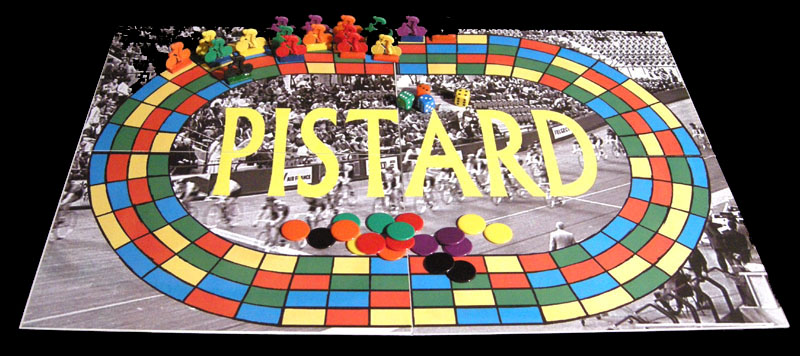
PISTARD
Anki Toner, 2005/2009

PISTARD started in 2005 as an open game project. What does that mean? It means that I provided the board and the riders to download, and an initial set of rules, PISTARD 1.0 (though I'd rather have called it "Pistard Beta"). You were expected to download the game, play it, make a new set of rules for these elements and send them to me.
I received some comments and rule suggestions, (Ludo Nauws, for instance, suggested to turn the game into an elimination race, the last rider being eliminated each lap or even each half-lap), but none were a radical departure from the initial set of rules as I had expected.
I did not think much about it myself until one day in 2009 that, for some unknown reason, a complete new set of rules came to my mind. It still used the colours on the track (which is the only differential factor in this game, otherwise it is just a 40-square 4-labe oval board like many others), but I did not match it with the base of the riders (like in Pistard 1.0) but with the colour of the dice. And I had a completely different game. And one I felt much better about.
So, from now on, when we talk about PISTARD we are talking about this "PISTARD 2" version.
Of course, the "open version" status of the game is still there. Feel free to add dice, cards, counters, riders, change the colours, etc... and make new sets of rules. All comments are welcome.
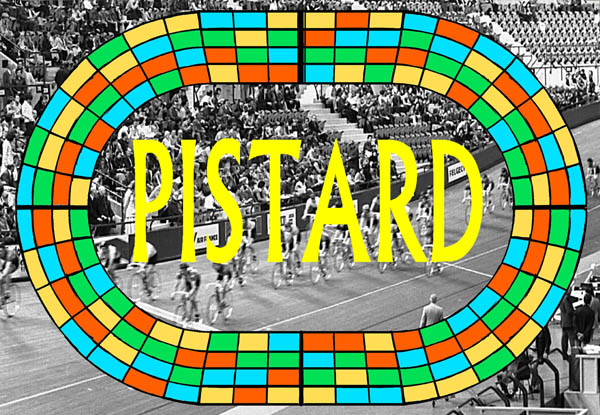
At the moment of writing this (2010), the rules for this game offer the possibility to play most track races, though without rider interaction (individual time trial or individual pursuit) are not so interesting. So far, the basic game is a one lap race with 3 or 4 riders per player. This would be a scratch race. With the present version of the rules (rev. 2.12) you can also play points races, elimination, sprint, team pursuit and team time trial.
Sprint, for instance, makes a very fast two player game which is, of course, luck-dependent (it is a dice game) but which has a fair amount of decision-taking.
Another race that works fairly well for two players is team pursuit.
These are the downloadable riders. They don't look too bad (...do they?)
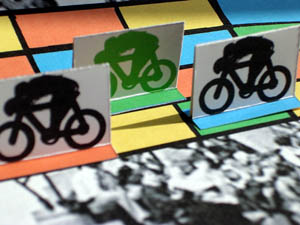
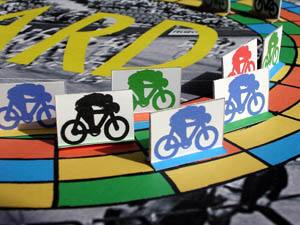
But I admit I rarely use the downloadable riders. As you may suspect I have plenty of riders at home. Here are two different sets of riders. If you look attentively you will notice that bases of the riders on the left are painted (to play the beta version of the game) while I use unpainted riders (probably borrowed from Maillot Arc-En-Ciel) on the right.
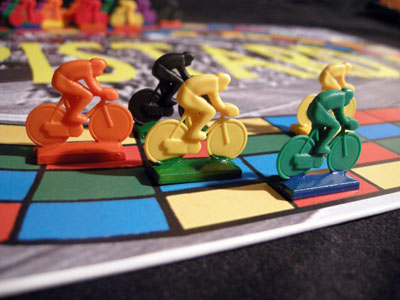
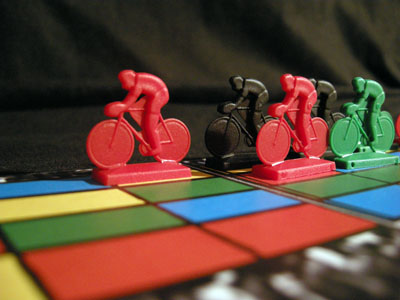
Here is a huge version of the game (printed on 4 A3 sheets, making it a A1 board, that is 82 x 51 cm). It is the right size to play with the 1/43 Norev riders. I usually play with this board.
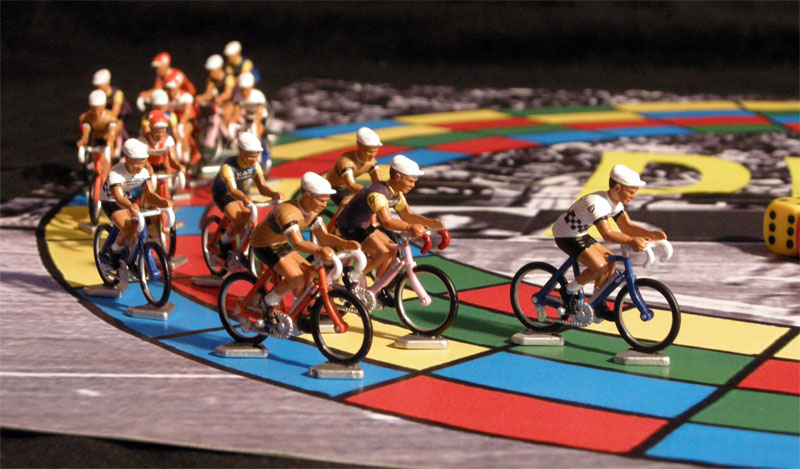

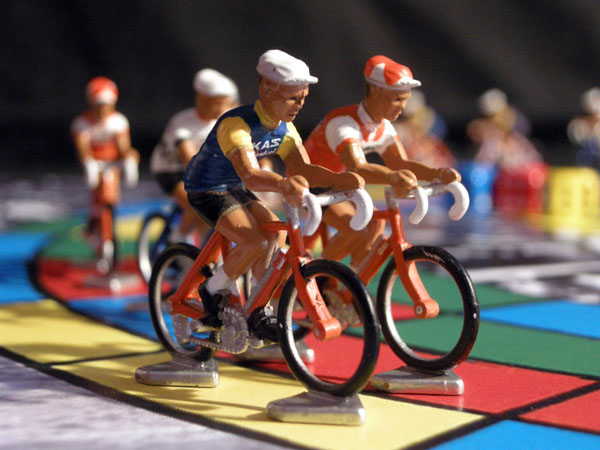
PISTARD (aka Pistard 2)
Game for 2 to 6 players
Material neededa) PISTARD track.
b) Four D6 dice, in matching colours with the PISTARD track squares. This means yellow, green, blue and orange (or red).
c) Cyclists. 1 to 4 cyclists per player, up to you. If you are 4 or less players, you can use the original PISTARD print-and-play riders, or else get some from other games. Small plastic riders like the ones featured in MAILLOT ARC-EN-CIEL are perfect.
d) Three tokens/chips per player. You can use poker chips, other games' counters, coins or whatever you have at hand. (Of course, if you take the riders from Maillot Arc-En-Ciel, take the tokens as well).Rules overview (download the PDF file for full rules with examples)
The cyclists move in the order of the race (first rider moves first, rider in the inner lane has precedence) . In his turn, a cyclist throws all four dice. He chooses ONE die to advance his cyclist.
His movement MUST end on: (a) a square matching the colour of the die or (b) orthogonally behind another rider.
If none of these possibilities can be accomplished, the cyclist does not move in this turn. (However, if he has at least a legal movement, he must move). The riders can only move ahead orthogonally or diagonally. (No lateral or backward moves). Riders cannot pass through an occupied square (nor end their move on it, of course). A movement diagonally outwards (towards an outer lane) costs one extra point. Riders can change as many lanes as they want in a turn but always in the same direction (inwards ?at no cost- or outwards ?at a cost of an extra pip for each lane-). However, riders cannot change lanes in both directions (inward and outward) in the same turn.
Each player receives three energy tokens (introduced in version 2.1 of the rules) at the beginning of the game. He may use them at any moment of the game to increase by one the value of one dice, as long as this value does not become higher than 6. However, he can only use them one at a time: He may not use two counters to increase the value of a die by two.
I generally play a one-lap race for a fast game, but rules for other races are included.
PISTARD BETA (aka Pistard 1.0)
Game for 2 to 4 players.
Material needed:
a) PISTARD track.
b) Four D6 dice per player. You probably have them at home.
c) Sixteen riders in 4 colours with the base in 4 different colours. (These are included in the game download)Rules overview (download the PDF file for full rules)
The riders move in the order of the race (first rider moves first, rider in the inner lane has precedence). When it's a player's turn to move his first rider, the player throws all his dice. Then he decides what dice he wants to use for that rider, moves the rider, discards this die and keeps the rest of the dice for the other riders. (Each player only throws his dice once in a turn). Of course the first player has to choose and move his first rider without seeing the dice of his rivals (which is not true the other way round). It's one of the problems of being ahead.
A rider may move orthogonally or diagonally ahead (never laterally or backwards). He may not travel through an occupied square (and of course he may not stop on it either).
When a rider falls in a square that matches the colour of his base, he may move orthogonally (not diagonally) ahead one extra square (if the square is free). If this square is still of the same colour, he may move another extra square.
When a rider falls in a square that is directly (orthogonally) behind another rider, he may benefit by the protection from the wind and advance an extra square diagonally. If this square is behind another rider he may NOT benefit again from wind protection, but if this square matches the colour of his base, he may move one extra square (even two if the colour match continues and there is another free square to move to) DIAGONALLY in the same direction he started his move .
LICENCE: I do not believe in copyright. I believe in the free access to information. Therefore I put this game in the Public Domain. This means that you can do whatever you want with it, even for commercial purposes (I know you won't, but it's up to you). Beware, though: I do NOT own the rights to the black and white picture I use as background (I don't even know who took the picture or who owns the rights), so:a) If you are going to use this game or part of it for commercial purposes, you'd rather remove or replace the picture.
b) If you took this picture, I'll be glad to talk to you, give you credit, even buy you a beer. If you own the rights to this picture but you did not take it, I'll be glad to talk to you anyway.
DOWNLOADS
> Download the board and riders (ZIP file, around 500kB)
You need this file and at least one set of rulesWhat you download is:
1) a 40-field long, 4-lane wide track. The fields are coloured in 4 different colours. In the zip file it is divided in 4 parts, each of them roughly A4 size (thus printable). The resulting board is A2 size.
2) 16 cyclists in 4 colours and with the base in 4 different colours, matching the colours of the track squares. These are the riders I designed for PISTARD 1.0, but you can use them for PISTARD 2.0 (and for many other games, of course).
> Download the complete PISTARD (2) rules with examples (PDF file)
Recommended rules!
> Download the PISTARD BETA (1.0) rules (PDF file)
For completists and experimenters
UPDATE 2021: Danny Culliane has sent this fine picture of his version of the game.
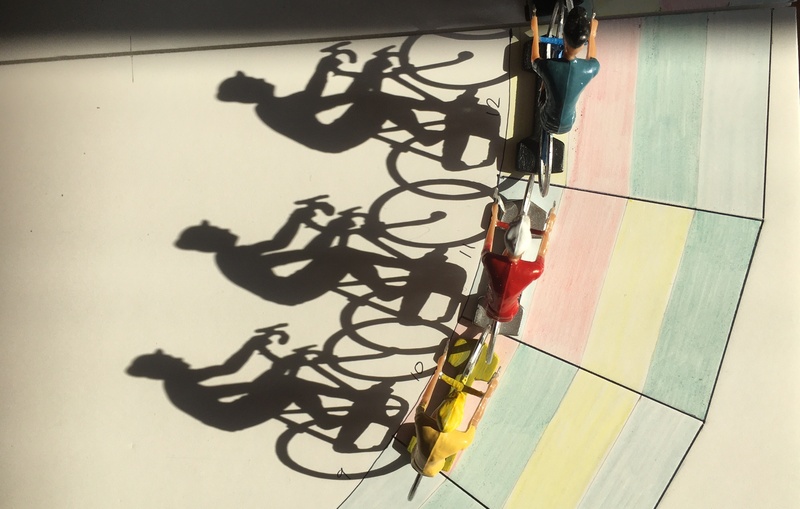
 |
 |
 |
 |
 |
|
CULTURE IDEAS |
TOTUM REVOLUTUM THUMBNAILS |
NAMES ALPHABETICAL |
CATEGORIES LISTS |
WHAT'S NEW BLOG |